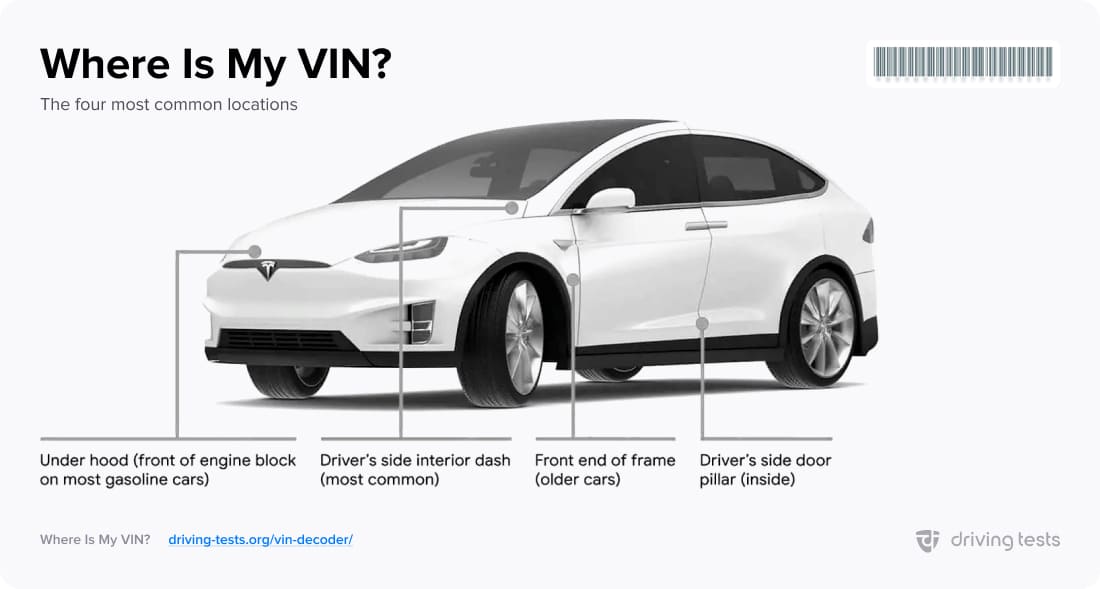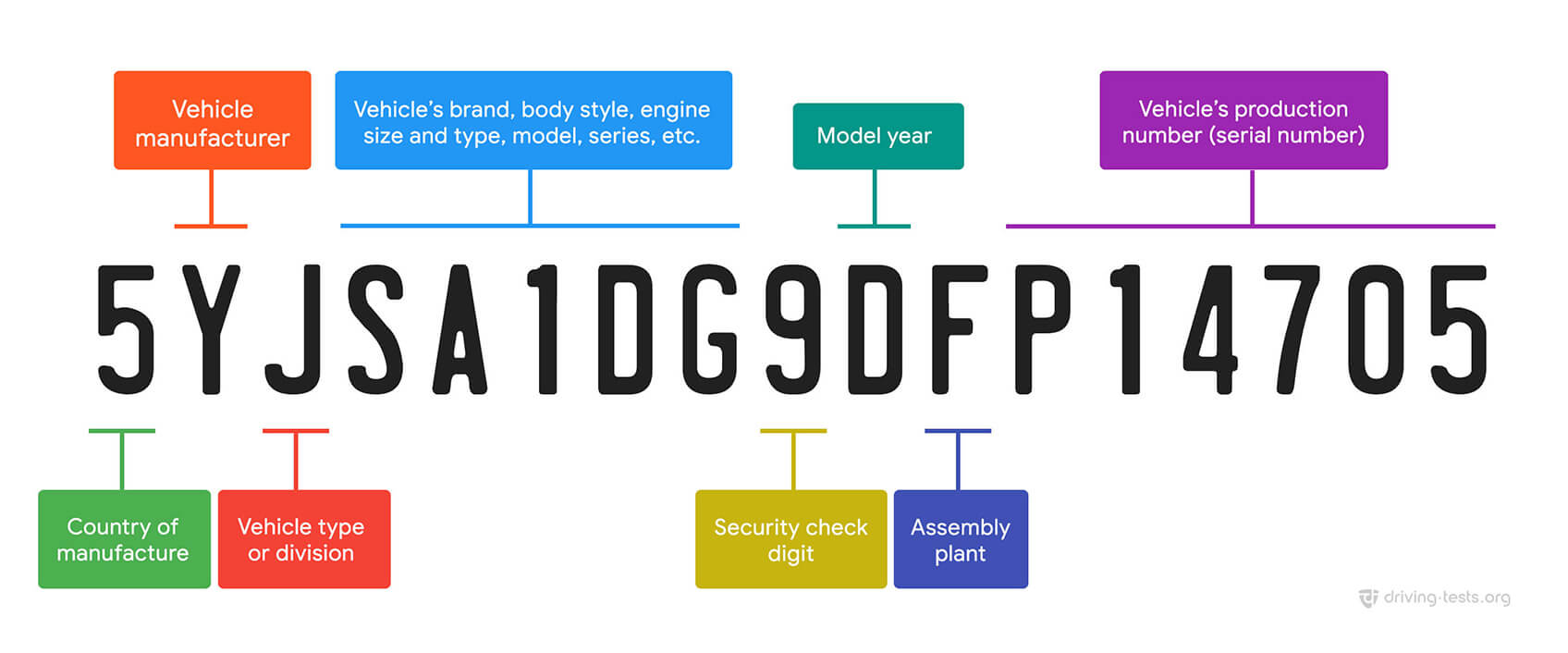Free VIN Decoder
Instant VIN lookup - get make-model specs & open recalls in seconds.
- Powered by official NHTSA & OEM data
- Updated every 24 hours
- Zero-cost – no email required
Instant VIN Lookup – How It Works
When you press Decode, our engine streams live data from NHTSA’s vPIC database and OEM technical bulletins. In under three seconds you’ll see build plant, engine code, safety recalls, and other key specs for cars, trucks, motorcycles, and semitrailers built since 1981 – entirely free, no signup.
Where to Find Your VIN
On most passenger vehicles the VIN sits at the base of the windshield on the driver’s-side dashboard. You’ll also find it on the driver’s-side door jamb, your registration card, and your proof-of-insurance slip. Motorcycles – steering neck below the bars. Semitrailers – left front of the trailer frame.
| How many characters: |
| 17 (digits and capital letters) |
| Where to find: |
| Dashboard on the driver's side |
| First digit stands for: |
| Country of manufacturer |

VIN Decoder vs VIN Check – What’s the Difference?
VIN Decoder / VIN Finder gives you build specs and open recalls for the entire make-model-year – perfect for fast research.
VIN Check / VIN Assist digs deeper: title brands, odometer timeline, lien records, auction photos, and prior sale prices. Run it before buying any used vehicle.
| Feature | Free VIN Decoder | Full History Report |
|---|---|---|
| Factory specs & build plant | ✔ | ✔ |
| Open safety recalls | ✔ | ✔ |
| Title brands & salvage history | — | ✔ |
| Odometer timeline | — | ✔ |
| Lien & theft records | — | ✔ |
| Cost | $0 | Low one-time fee |
Model-Year Codes 1980-2035
Every tenth character in a VIN reveals the model year. Use the table below to decode any vehicle from 1980 through 2035.
| Code | Year | Code | Year | Code | Year | Code | Year |
|---|---|---|---|---|---|---|---|
| A | 1980 | L | 1990 | Y | 2000 | A | 2010 |
| B | 1981 | M | 1991 | 1 | 2001 | B | 2011 |
| C | 1982 | N | 1992 | 2 | 2002 | C | 2012 |
| D | 1983 | P | 1993 | 3 | 2003 | D | 2013 |
| E | 1984 | R | 1994 | 4 | 2004 | E | 2014 |
| F | 1985 | S | 1995 | 5 | 2005 | F | 2015 |
| G | 1986 | T | 1996 | 6 | 2006 | G | 2016 |
| H | 1987 | V | 1997 | 7 | 2007 | H | 2017 |
| J | 1988 | W | 1998 | 8 | 2008 | J | 2018 |
| K | 1989 | X | 1999 | 9 | 2009 | K | 2019 |
| L | 2020 | M | 2021 | N | 2022 | P | 2023 |
| R | 2024 | S | 2025 | T | 2026 | V | 2027 |
| W | 2028 | X | 2029 | Y | 2030 | 1 | 2031 |
| 2 | 2032 | 3 | 2033 | 4 | 2034 | 5 | 2035 |
WMI Country & Manufacturer Codes
The first three characters – the World Manufacturer Identifier – pinpoint where and by whom the vehicle was built. Reference the continent-sorted table below to identify any WMI.
| WMI | Region | Notes |
|---|---|---|
| A-H | Africa | AA-AH = South Africa |
| J-R | Asia | >J = Japan KL-KR = South Korea L = China MA-ME = India MF-MK = Indonesia ML-MR = Thailand MS = Myanmar PA-PE = Philippines PL-PR = Malaysia RF-RG = Taiwan |
| S-Z | Europe | SA-SM = United Kingdom SN-ST, W = Germany SU-SZ = Poland TA-TH = Switzerland TJ-TP = Czech Republic TR-TV = Hungary TW = Portugal VA-VE = Austria VF-VR = France VS-VW = Spain VX-V2 = Yugoslavia XL-XM = The Netherlands XS-XW = USSR X3-X0 = Russia YA-YE = Belgium YF-YK = Finland YS-YW = Sweden ZA-ZR = Italy |
| 1-5 | North America | 1, 4, 5 = United States 2 = Canada 3 = Mexico |
| 6-7 | Oceania | 6A-6W = Australia 7A-7E = New Zealand |
| 8-0 | South America | 8A-8E = Argentina 8F-8J = Chile 8X-82 = Venezuela 9A-9E, 93-99 = Brazil 9F-9J = Colombia |
VIN FAQs
Is the VIN check really free?
Yes – decoding factory specs and open recalls costs nothing. A paid Full History Report is optional if you need lien, odometer and title-brand data.
Can I decode a pre-1981 VIN?
Older VINs use 11–13 characters and weren’t standardised, so results may be limited. For best accuracy, request documentation from the seller.
What if my VIN shows an O or I?
The letters I, O and Q are never used in modern VINs. Double-check – it’s usually a zero or the number one.
How often is your data updated?
NHTSA vPIC and safety-recall feeds stream live; OEM bulletins refresh daily, so specs and recall status are always current.
Is personal data in a VIN report legal to show?
Yes. All personal identifiers are removed under DPPA and Canadian privacy rules. Reports reveal only vehicle-related facts.
About Our VIN-Data Pipeline
Where Our Information Comes From
We stitch together multiple government and private-sector data feeds to create both our free make-model-year report and the deeper, vehicle-specific Full History Report.
| Data Feed | Source Type | What It Adds | Update Frequency |
|---|---|---|---|
| NHTSA vPIC & Recall APIs | U.S. federal (open) | Factory specs, build plant, safety recalls | Live stream |
| OEM Technical Bulletins | Manufacturer portals | Service bulletins, common failure points | Live stream |
| Insurance & Auction Clearinghouses | Private aggregators | Total-loss flags, salvage dates, odometer snaps | Daily |
| Warranty & Valuation DBs | Industry partners | In-service date, warranty status, MSRP & retail | Live stream |
| Dealer-Reported Listings | Franchise & independent | Trim confirmation, option codes | Live stream |
VIN Finder & VIN Number Lookup – What’s Free?
Free VIN Finder — A vin number lookup free of charge that returns make-model specs, build plant, and open recalls for any 17-digit VIN. No email, no credit card.
Is VIN Assist really free?
Yes. VIN Assist is our free decoder that shows factory specs and open recalls. A paid Full History Report is optional if you need lien, odometer, or salvage details.
What does VIN Finder show?
VIN Finder pulls live NHTSA and OEM data to display make, model, engine code, build plant, and any active safety recalls – all in under three seconds.
What Is a VIN Number?
A Vehicle Identification Number is a 17-character ID stamped on every road-legal vehicle since 1981. It encodes where, when, and how the vehicle was built and acts as a fingerprint for recalls, title brands, and theft recovery.
Transparency & Compliance
Personal data is redacted per DPPA and Canadian privacy laws. We are not a government agency; we aggregate and enrich public data so you can search it in one place. Always confirm critical facts with the seller, a licensed mechanic, or your DMV before purchase.
State DMV Practice-Test Hubs
Have Questions?
Reach out any time at info@driving-tests.org.
